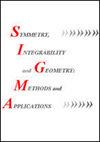Stationary Flows Revisited
IF 1
3区 物理与天体物理
Q2 MATHEMATICS
Symmetry Integrability and Geometry-Methods and Applications
Pub Date : 2022-10-23
DOI:10.3842/SIGMA.2023.015
引用次数: 2
Abstract
In this paper we revisit the subject of stationary flows of Lax hierarchies of a coupled KdV class. We explain the main ideas in the standard KdV case and then consider the dispersive water waves (DWW) case, with respectively 2 and 3 Hamiltonian representations. Each Hamiltonian representation gives us a different form of stationary flow. Comparing these, we construct Poisson maps, which, being non-canonical, give rise to bi-Hamiltonian representations of the stationary flows. An alternative approach is to use the Miura maps, which we do in the case of the DWW hierarchy, which has two ''modifications''. This structure gives us 3 sequences of Poisson related stationary flows. We use the Poisson maps to build a tri-Hamiltonian representation of each of the three stationary hierarchies. One of the Hamiltonian representations allows a multi-component squared eigenfunction expansion, which gives N degrees of freedom Hamiltonians, with first integrals. A Lax representation for each of the stationary flows is derived from the coupled KdV matrices. In the case of 3 degrees of freedom, we give a generalisation of our Lax matrices and Hamiltonian functions, which allows a connection with the rational Calogero-Moser (CM) system. This gives a coupling of the CM system with other potentials, along with a Lax representation. We present the particular case of coupling one of the integrable Hénon-Heiles systems to CM.重新审视静止流动
在本文中,我们重新讨论了耦合KdV类Lax层次的平稳流问题。我们解释了标准KdV情况下的主要思想,然后考虑色散水波(DWW)情况,分别用2和3个哈密顿表示。每种哈密顿表示都给了我们一种不同形式的定常流。比较这些,我们构造了泊松映射,它是非正则的,产生了平稳流的双哈密顿表示。另一种方法是使用Miura映射,这是我们在DWW层次结构的情况下所做的,它有两个“修改”。该结构给出了3个泊松相关平稳流序列。我们使用泊松映射来建立三个平稳层次中每一个的三哈密顿表示。其中一个哈密顿表示允许多分量平方本征函数展开,该展开给出了具有第一积分的N个自由度哈密顿量。从耦合的KdV矩阵中导出每个平稳流的Lax表示。在3自由度的情况下,我们给出了Lax矩阵和哈密顿函数的推广,这允许与有理Calogero-Moser(CM)系统建立联系。这给出了CM系统与其他电势的耦合,以及Lax表示。我们给出了将一个可积的Hénon-Heiles系统耦合到CM的特殊情况。
本文章由计算机程序翻译,如有差异,请以英文原文为准。
求助全文
约1分钟内获得全文
求助全文
来源期刊
CiteScore
1.80
自引率
0.00%
发文量
87
审稿时长
4-8 weeks
期刊介绍:
Scope
Geometrical methods in mathematical physics
Lie theory and differential equations
Classical and quantum integrable systems
Algebraic methods in dynamical systems and chaos
Exactly and quasi-exactly solvable models
Lie groups and algebras, representation theory
Orthogonal polynomials and special functions
Integrable probability and stochastic processes
Quantum algebras, quantum groups and their representations
Symplectic, Poisson and noncommutative geometry
Algebraic geometry and its applications
Quantum field theories and string/gauge theories
Statistical physics and condensed matter physics
Quantum gravity and cosmology.

 求助内容:
求助内容: 应助结果提醒方式:
应助结果提醒方式:


